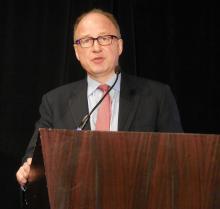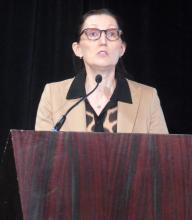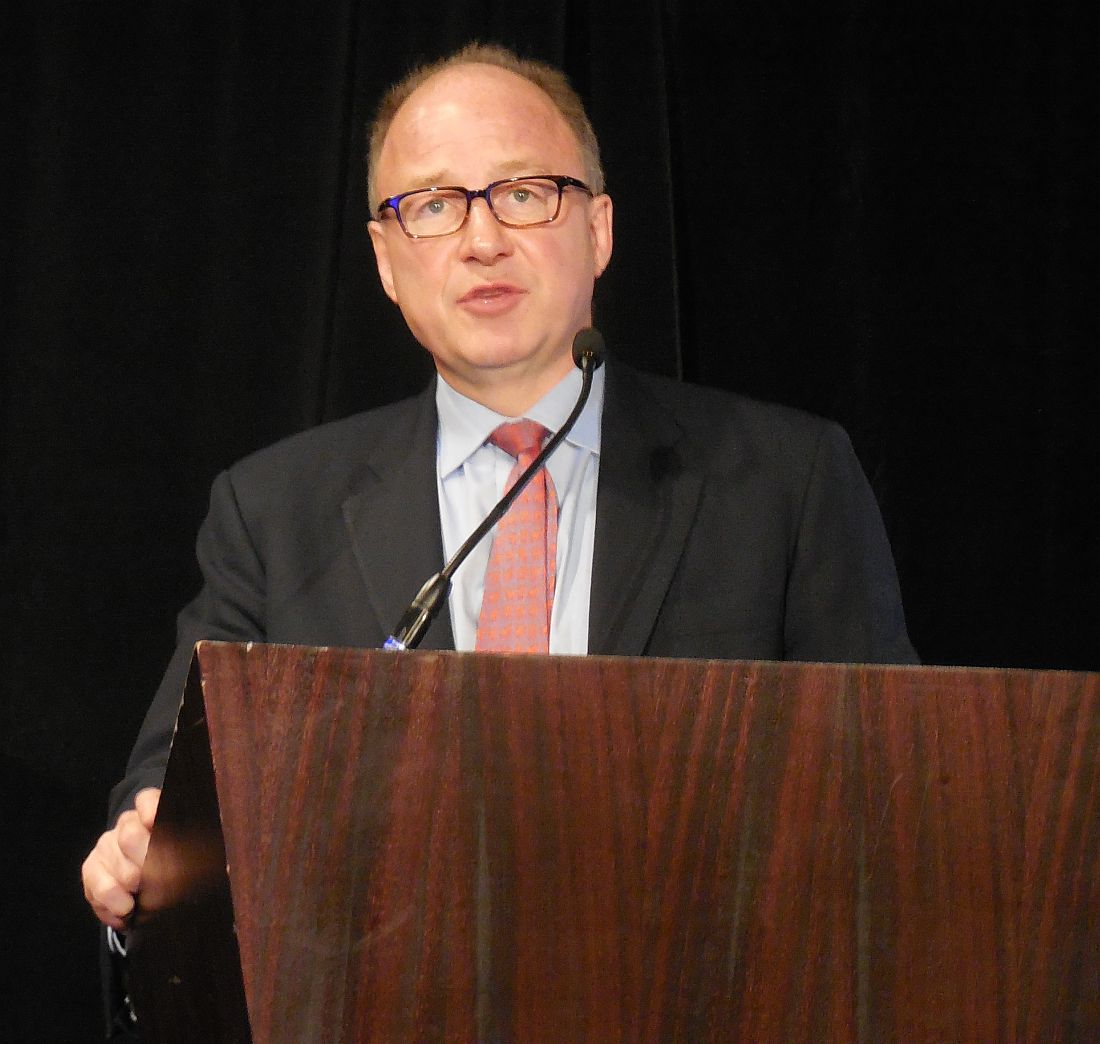User login
NEW YORK – Recent trial results have shown the importance of treating patients with multiple myeloma with the immunomodulator lenalidomide for maintaining negative minimal residual disease and sustained complete responses following autologous stem cell transplantation, experts said at a conference held by Imedex.
“How do you keep the therapy pedal to the metal over time? Lenalidomide is easy to deliver, convenient, and improves progression-free survival and overall survival,” said Paul G. Richardson, MD, professor of medicine at Harvard University and clinical program leader of the Multiple Myeloma Center at the Dana-Farber Cancer Institute in Boston. “Lenalidomide maintenance is standard of care. It provides a platform on which you can reliably add new agents for maintenance of remission following autologous stem cell transplantation,” in patients with multiple myeloma.
In a meta-analysis of three randomized, controlled trials with 1,208 patients with multiple myeloma who had undergone induction and autologous stem cell transplant, the overall mortality rate dropped by 0.75 (95% CI, 0.63-0.90) among patients maintained on lenalidomide, compared with placebo (J Clin Oncol. 2016;34:suppl;abstract 8001).
A third study that Dr. Richardson cited showed the difficulty of improving on lenalidomide. The BMT CTN 0702 (Stem Cell Transplant With Lenalidomide Maintenance in Patients With Multiple Myeloma) trial randomized 758 multiple myeloma patients to three different autologous stem cell transplant regimens, each followed by lenalidomide maintenance. One arm followed the transplant with four cycles of consolidation therapy with lenalidomide, dexamethasone, and bortezomib (Velcade); one arm used two tandem transplantations; and the third arm used a single transplantation. All three arms had similar rates of progression-free survival and overall survival during follow-up (Blood. 2016 Dec 6;LBA-1). The results showed that “lenalidomide maintenance is an equalizer,” Dr. Richardson said.
She cited a U.S., multicenter, phase II study that followed 66 newly diagnosed patients with multiple myeloma who proceeded through induction, autologous stem cell transplantation, and multiple cycles of consolidation therapy with a regimen of lenalidomide, the proteasome inhibitor carfilzomib (Kyprolis), and dexamethasone. Fifty patients went through 18 cycles of this consolidation regimen and showed an 84% rate of stringent complete response, “the first time we’ve seen such results,” said Dr. Lentzsch, director of the Multiple Myeloma and Amyloidosis Program at Columbia University in New York. “This translated into an excellent” progression-free survival of 86% after 3 years and an overall survival of 95% after 3 years (Blood. 2016 Dec 5;Abstract 675). “I’m pretty impressed” by the results, she added.
An advantage of the combined regimen used in this study is that it is “relatively well tolerated,” as well as effective for keeping patients in remission, Dr. Lentzsch said. However, she highlighted that this was a small study, so its treatment implications are limited for the time being. “For high-risk patients, use the full combination. For everyone else, we need to wait for results from a randomized, controlled trial,” she advised.
Dr. Richardson has been a consultant to Celgene, the company that markets lenalidomide, and is also a consultant to Genmab, Janssen, Novartis, Oncopeptides, and Takeda and has received research funding from Celgene and Takeda. Dr. Lentzsch has been a consultant to Amgen, Bristol-Myers Squibb, and Caelum Biosciences.
mzoler@frontlinemedcom.com
On Twitter @mitchelzoler
NEW YORK – Recent trial results have shown the importance of treating patients with multiple myeloma with the immunomodulator lenalidomide for maintaining negative minimal residual disease and sustained complete responses following autologous stem cell transplantation, experts said at a conference held by Imedex.
“How do you keep the therapy pedal to the metal over time? Lenalidomide is easy to deliver, convenient, and improves progression-free survival and overall survival,” said Paul G. Richardson, MD, professor of medicine at Harvard University and clinical program leader of the Multiple Myeloma Center at the Dana-Farber Cancer Institute in Boston. “Lenalidomide maintenance is standard of care. It provides a platform on which you can reliably add new agents for maintenance of remission following autologous stem cell transplantation,” in patients with multiple myeloma.
In a meta-analysis of three randomized, controlled trials with 1,208 patients with multiple myeloma who had undergone induction and autologous stem cell transplant, the overall mortality rate dropped by 0.75 (95% CI, 0.63-0.90) among patients maintained on lenalidomide, compared with placebo (J Clin Oncol. 2016;34:suppl;abstract 8001).
A third study that Dr. Richardson cited showed the difficulty of improving on lenalidomide. The BMT CTN 0702 (Stem Cell Transplant With Lenalidomide Maintenance in Patients With Multiple Myeloma) trial randomized 758 multiple myeloma patients to three different autologous stem cell transplant regimens, each followed by lenalidomide maintenance. One arm followed the transplant with four cycles of consolidation therapy with lenalidomide, dexamethasone, and bortezomib (Velcade); one arm used two tandem transplantations; and the third arm used a single transplantation. All three arms had similar rates of progression-free survival and overall survival during follow-up (Blood. 2016 Dec 6;LBA-1). The results showed that “lenalidomide maintenance is an equalizer,” Dr. Richardson said.
She cited a U.S., multicenter, phase II study that followed 66 newly diagnosed patients with multiple myeloma who proceeded through induction, autologous stem cell transplantation, and multiple cycles of consolidation therapy with a regimen of lenalidomide, the proteasome inhibitor carfilzomib (Kyprolis), and dexamethasone. Fifty patients went through 18 cycles of this consolidation regimen and showed an 84% rate of stringent complete response, “the first time we’ve seen such results,” said Dr. Lentzsch, director of the Multiple Myeloma and Amyloidosis Program at Columbia University in New York. “This translated into an excellent” progression-free survival of 86% after 3 years and an overall survival of 95% after 3 years (Blood. 2016 Dec 5;Abstract 675). “I’m pretty impressed” by the results, she added.
An advantage of the combined regimen used in this study is that it is “relatively well tolerated,” as well as effective for keeping patients in remission, Dr. Lentzsch said. However, she highlighted that this was a small study, so its treatment implications are limited for the time being. “For high-risk patients, use the full combination. For everyone else, we need to wait for results from a randomized, controlled trial,” she advised.
Dr. Richardson has been a consultant to Celgene, the company that markets lenalidomide, and is also a consultant to Genmab, Janssen, Novartis, Oncopeptides, and Takeda and has received research funding from Celgene and Takeda. Dr. Lentzsch has been a consultant to Amgen, Bristol-Myers Squibb, and Caelum Biosciences.
mzoler@frontlinemedcom.com
On Twitter @mitchelzoler
NEW YORK – Recent trial results have shown the importance of treating patients with multiple myeloma with the immunomodulator lenalidomide for maintaining negative minimal residual disease and sustained complete responses following autologous stem cell transplantation, experts said at a conference held by Imedex.
“How do you keep the therapy pedal to the metal over time? Lenalidomide is easy to deliver, convenient, and improves progression-free survival and overall survival,” said Paul G. Richardson, MD, professor of medicine at Harvard University and clinical program leader of the Multiple Myeloma Center at the Dana-Farber Cancer Institute in Boston. “Lenalidomide maintenance is standard of care. It provides a platform on which you can reliably add new agents for maintenance of remission following autologous stem cell transplantation,” in patients with multiple myeloma.
In a meta-analysis of three randomized, controlled trials with 1,208 patients with multiple myeloma who had undergone induction and autologous stem cell transplant, the overall mortality rate dropped by 0.75 (95% CI, 0.63-0.90) among patients maintained on lenalidomide, compared with placebo (J Clin Oncol. 2016;34:suppl;abstract 8001).
A third study that Dr. Richardson cited showed the difficulty of improving on lenalidomide. The BMT CTN 0702 (Stem Cell Transplant With Lenalidomide Maintenance in Patients With Multiple Myeloma) trial randomized 758 multiple myeloma patients to three different autologous stem cell transplant regimens, each followed by lenalidomide maintenance. One arm followed the transplant with four cycles of consolidation therapy with lenalidomide, dexamethasone, and bortezomib (Velcade); one arm used two tandem transplantations; and the third arm used a single transplantation. All three arms had similar rates of progression-free survival and overall survival during follow-up (Blood. 2016 Dec 6;LBA-1). The results showed that “lenalidomide maintenance is an equalizer,” Dr. Richardson said.
She cited a U.S., multicenter, phase II study that followed 66 newly diagnosed patients with multiple myeloma who proceeded through induction, autologous stem cell transplantation, and multiple cycles of consolidation therapy with a regimen of lenalidomide, the proteasome inhibitor carfilzomib (Kyprolis), and dexamethasone. Fifty patients went through 18 cycles of this consolidation regimen and showed an 84% rate of stringent complete response, “the first time we’ve seen such results,” said Dr. Lentzsch, director of the Multiple Myeloma and Amyloidosis Program at Columbia University in New York. “This translated into an excellent” progression-free survival of 86% after 3 years and an overall survival of 95% after 3 years (Blood. 2016 Dec 5;Abstract 675). “I’m pretty impressed” by the results, she added.
An advantage of the combined regimen used in this study is that it is “relatively well tolerated,” as well as effective for keeping patients in remission, Dr. Lentzsch said. However, she highlighted that this was a small study, so its treatment implications are limited for the time being. “For high-risk patients, use the full combination. For everyone else, we need to wait for results from a randomized, controlled trial,” she advised.
Dr. Richardson has been a consultant to Celgene, the company that markets lenalidomide, and is also a consultant to Genmab, Janssen, Novartis, Oncopeptides, and Takeda and has received research funding from Celgene and Takeda. Dr. Lentzsch has been a consultant to Amgen, Bristol-Myers Squibb, and Caelum Biosciences.
mzoler@frontlinemedcom.com
On Twitter @mitchelzoler


